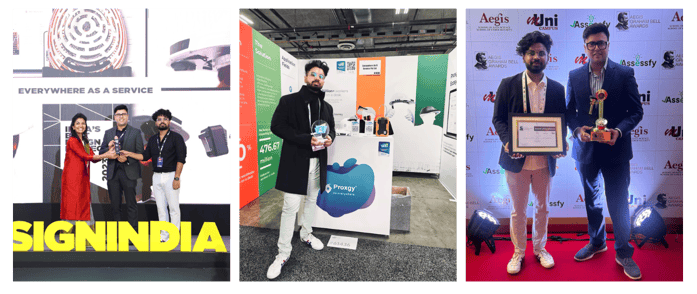SMARTHAT
Company: Proxgy
Role: Lead Designer(Physical & Digital design)
Team Credits: 10 Members (2 Designers, 1 Mechanical Engineer, 1 PCB Deisgner, 2 Embedded Electronics, 2 Front End, 2 Back End)
Timeline: July 2022 - Present
Redefining Safety for Industrial Workers
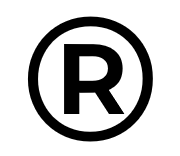
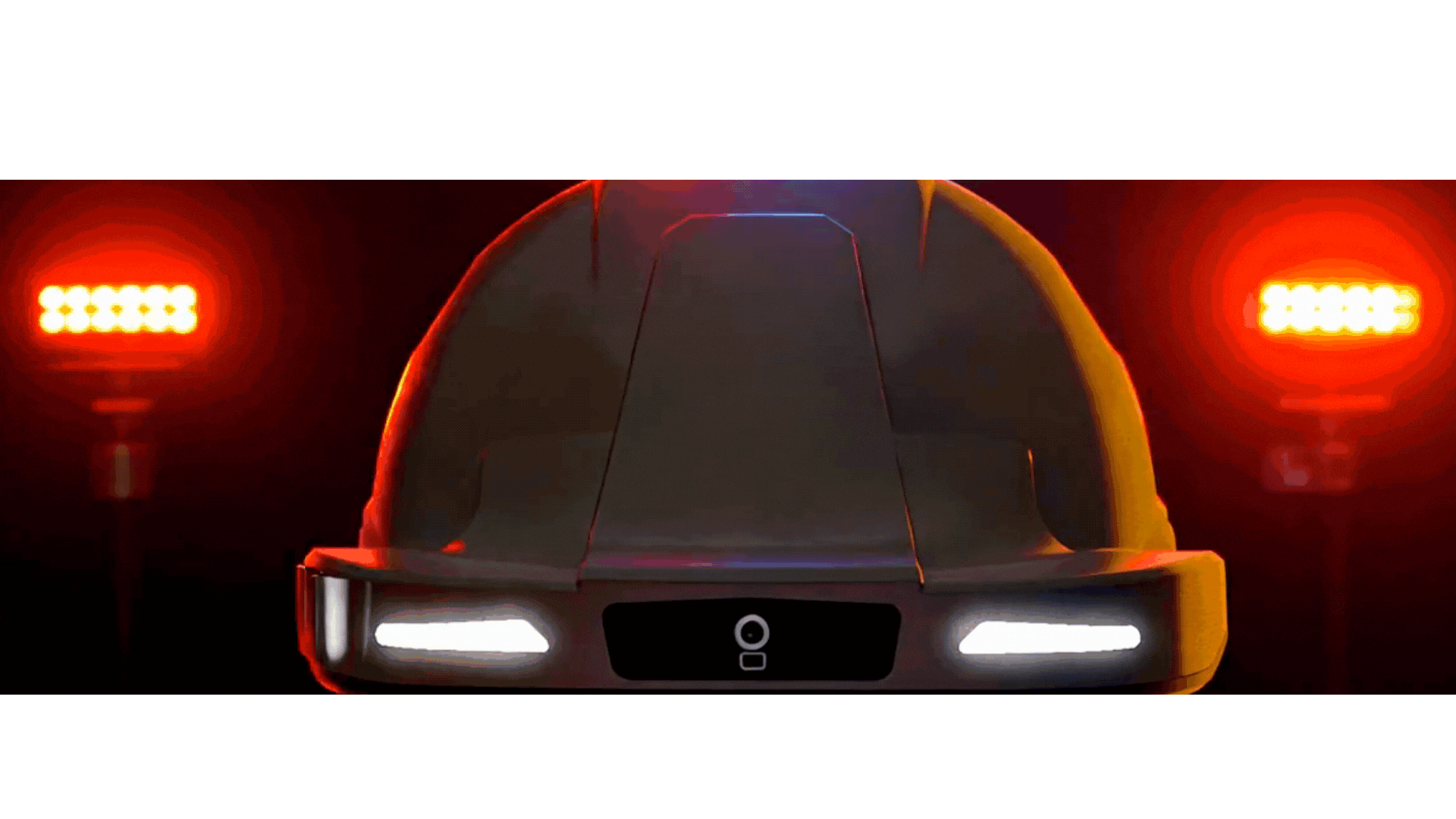
SmartHat is a groundbreaking industrial safety helmet designed to enhance the safety and productivity of workers in hazardous environments such as construction, mining, and oil & gas. As the lead designer, I spearheaded the project from concept to execution, ensuring that the product’s form, function, and user experience aligned with industry demands for safety and innovation.
Overview
Problem Statement
White-collar workers have access to various productivity-enhancing tools that provide better management, task-specific data, and improved ROI. However, these tools, such as laptops and tablets, are not feasible for blue-collar workers operating in physically demanding environments like mines, construction sites, and oil & gas fields. In such conditions, the use of conventional digital tools is impractical due to environmental hazards, mobility constraints, and the need for hands-free solutions. Despite this, blue-collar workers play a critical role in the industrial workforce, accounting for nearly 60% of all jobs. As industries move towards a new age of industrial revolution, driven by connectivity and data, there is a vast opportunity to introduce innovative solutions tailored for these deskless workers in cash-rich industries that are ripe for technological transformation.
Increased Revenue
Increased customer satisfaction
Empowered workers
Better communication between blue collar and white collar
Zero touch provisioning for both devices
Tentative production plan
10k by March 25
30k by July 25
100k by March 26
Any addition use cases for AI
Faster and more efficient Communication
More Safety features
Lesser Rescue time
Increase productivity
Data access of site for Post-Facto analysis
"A suite of proprietary IoT products and customized software tools designed to connect industrial workers at the edge, driving safety, productivity, and real-time insights in the most demanding environments."
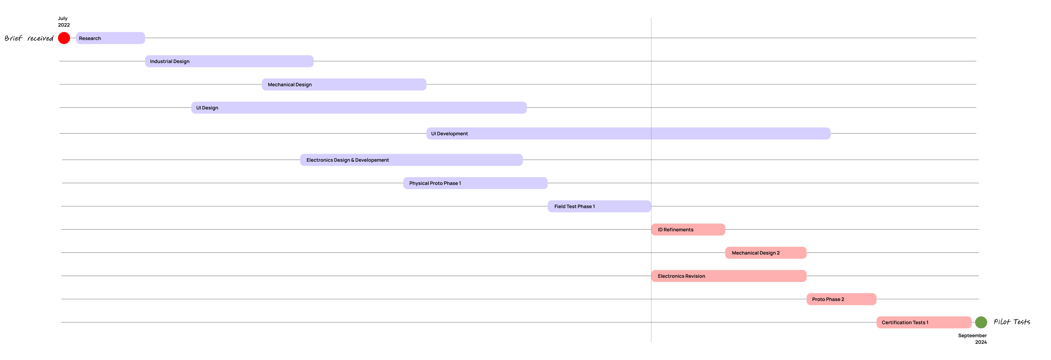

Shift logging with Check in
Helmet to Helmet and Dashboard calling
Work reporting - Inspection - data collection
Work Reporting - Remote assistance
Work monitoring for performance review
Work updates - Regular calls, Videos, Pics, Voice notes
Incident/SOS reporting
Rescue & Evacuation
User Goals
Customer Goals
Business Goals
Timeline
Rough visual presentation of the whole timeline from brief to delivery.
26 months(not to scale)
Physical Design
Starting from the reference of a standard industrial hard hat, we aimed to design a helmet that integrates advanced functionality while maintaining a recognizable form factor. Smarthat’s design explores minimalistic forms, striking a balance between modern aesthetics and essential ergonomics. During sketching and form exploration, key factors like weight, visual cone, and user accessibility were prioritized. Multiple iterations focused on the strategic placement of buttons and lights, ensuring they are easy to reach and operate. The helmet’s brim was another critical design element, carefully adjusted to house electronics without obstructing the user's view, preserving a wide visual cone for optimal safety and comfort.
In collaboration with the mechanical and electronics teams, we moved into the CAD phase to refine the internal real estate of the SmartHat. We meticulously planned space for essential electronic components such as the PCB, wiring, antennas, battery, connectors, and light pipes, ensuring that each component fit seamlessly within the helmet. Simultaneously, we adjusted the helmet's thickness to maintain a balance between achieving the required safety standards and keeping the weight manageable for comfortable, long-term wear.
We began the prototype phase with multiple PLA prototypes to explore and ideate different forms for the SmartHat. Once the form was finalized, we progressed to MJF prototypes to perform fitment checks and conduct electronics testing, ensuring all components fit correctly and functioned as intended. Finally, to assess durability and performance in real-world conditions, we created VC prototypes for waterproof testing and field testing. These stages allowed us to validate both the design and the functionality of the helmet before moving to the final production phase.
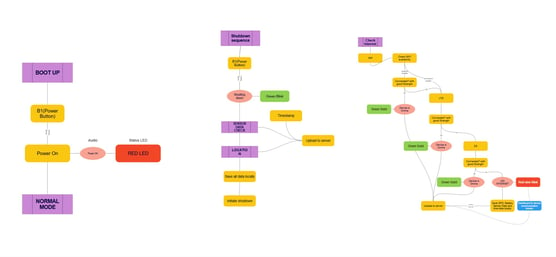

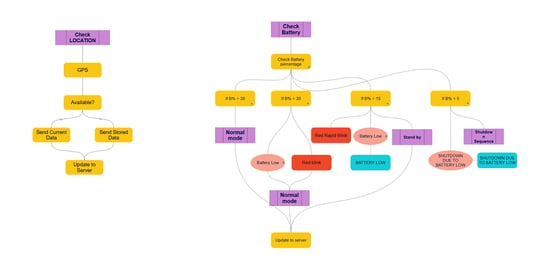

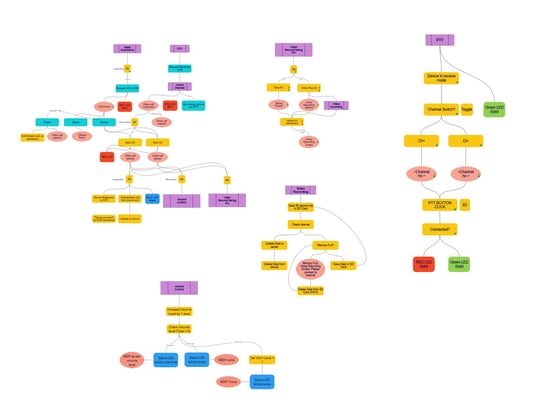


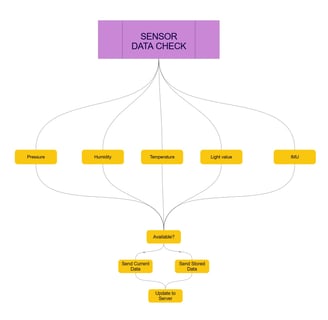

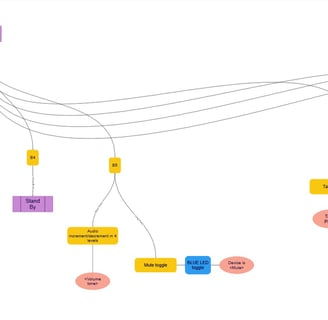
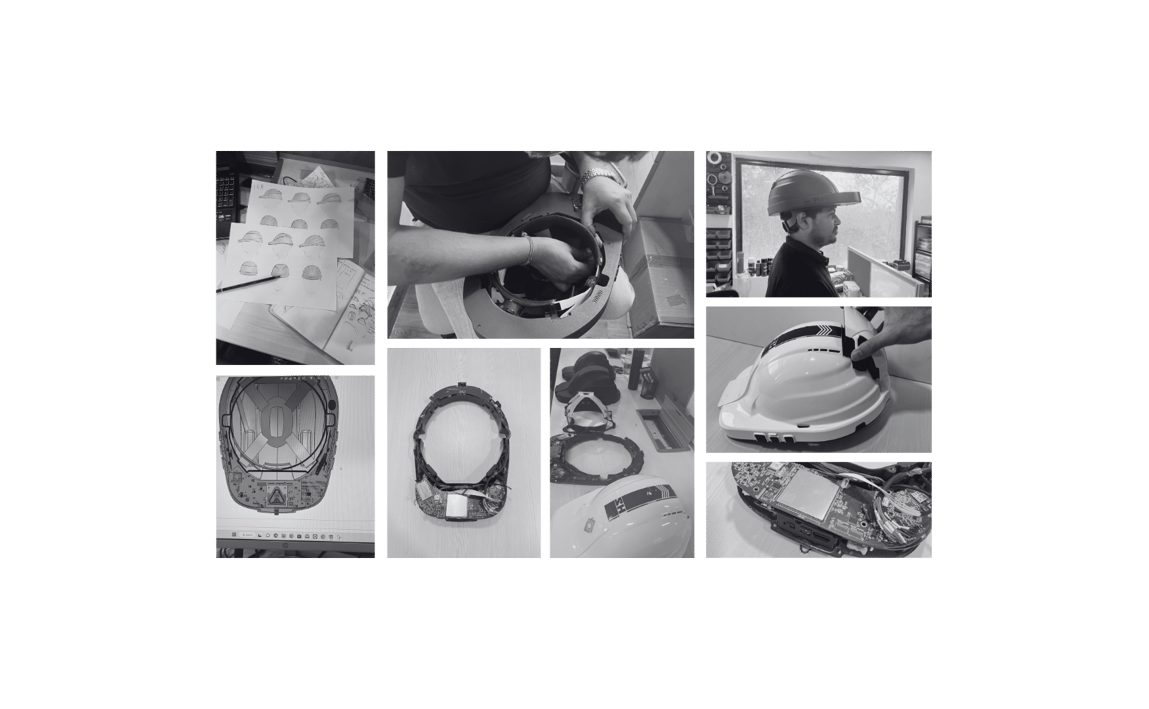


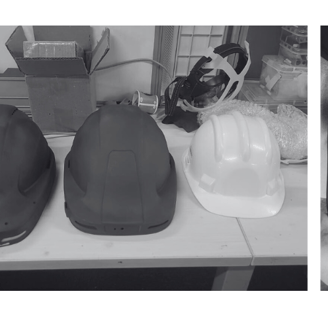

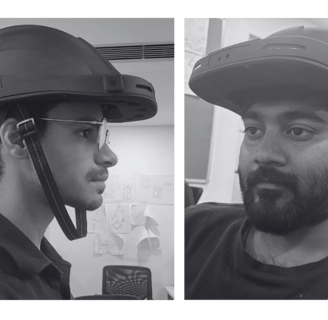
Dashboard Design
Low Fi Prototype
UI Elements
In the digital design phase, we conducted extensive research on existing solutions for blue-collar workforce management to inform the development of a comprehensive dashboard. The primary goal was to create a platform that could manage and monitor a fleet of helmet users, enabling tracking of their tasks, location, physical and environmental data, and more. Key features included video calling for remote assistance and managing SOS situations, providing real-time support to users in the field. This SaaS-based dashboard, in tandem with the SmartHat helmet, was designed to bridge the gap between blue-collar and white-collar workers, forming a cohesive ecosystem that empowers industrial workers with improved safety and efficiency.
In the low-fidelity layout phase, we focused on structuring core features to ensure the dashboard was both functional and user-friendly. These features included the Home Page, Organization Management, Task Management, Shift Management, User Management, Profile Management, SOS Management, and a Control Centre for accessibility and settings. By analyzing task frequency and user needs, we created an interactive layout designed to simplify navigation and provide a seamless experience, ensuring that key functions were easily accessible and intuitive to use.
Some of the final screens
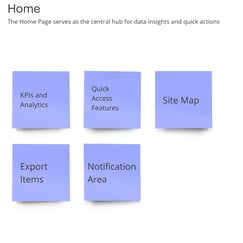
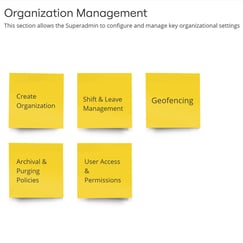
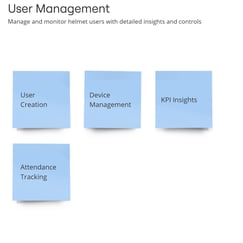
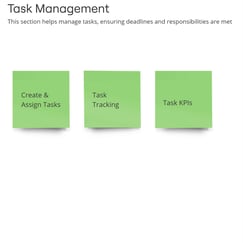
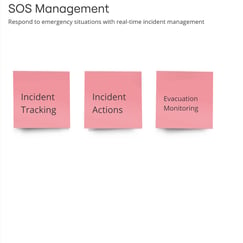
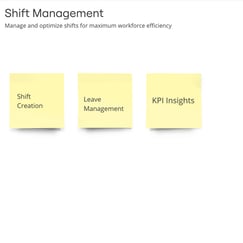
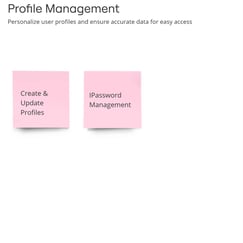
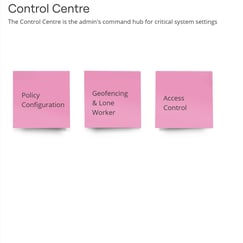
The visual style for the Smarthat dashboard aligns with the industrial nature of its use cases, aiming for a professional, minimal, and data-focused interface that avoids visual clutter while enhancing usability. Key visual principles include:
Color Palette: The color palette is grounded in neutral tones to create a calm, focused interface. Functional color accents (e.g., red for SOS, green for active status) are used strategically to draw attention to critical information without overwhelming the user.
Typography: Clean, sans-serif fonts were chosen to ensure readability, especially for long working hours. Font weights vary subtly to distinguish headers from body text, while labels and captions maintain a smaller, easily readable size.
Spacing and Layout: Generous use of spacing keeps the interface uncluttered and easy to navigate. A card-based layout helps separate different types of data, creating a modular look that feels organized and intuitive.
Visual Hierarchy: Strong visual hierarchy is maintained using size, color, and placement, so high-priority information (e.g., SOS alerts, active tasks) naturally draws the eye. This ensures that the most important actions and data points are immediately accessible.
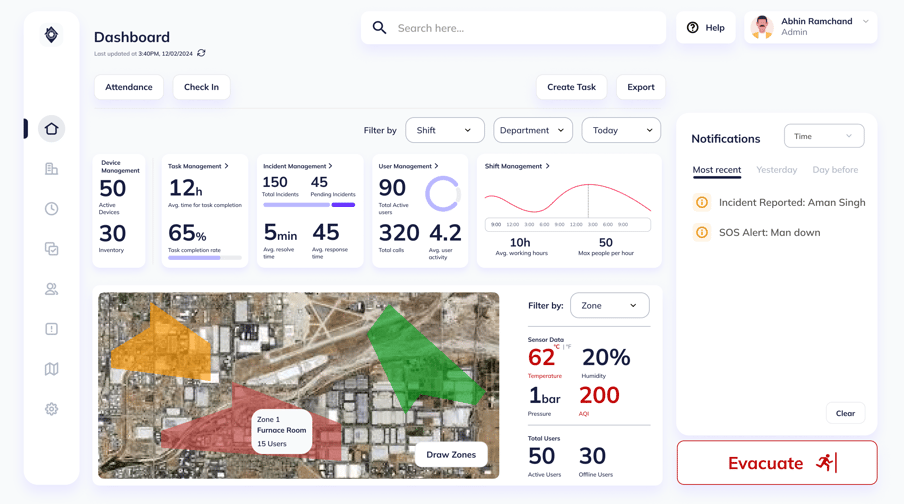

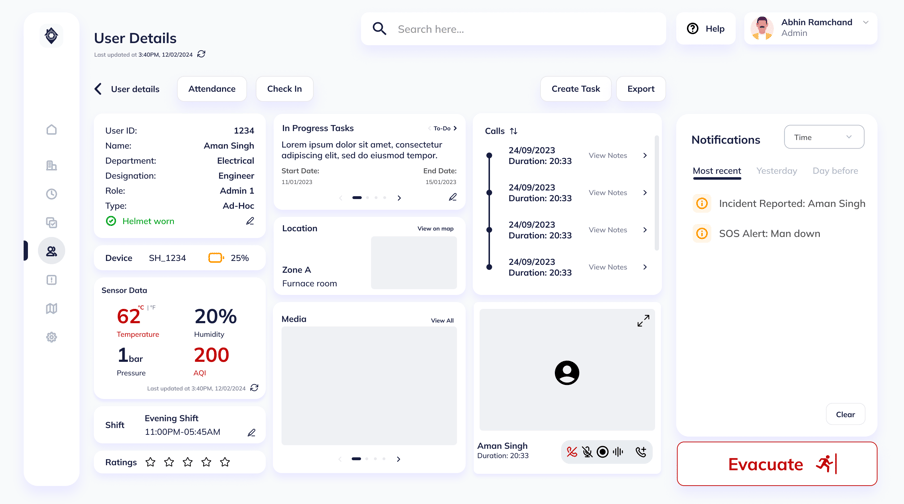

The overarching goal for the SmartHat dashboard design is to empower managers and supervisors with an actionable, responsive, and intuitive interface. By focusing on clear information architecture, high-contrast visual alerts, and an ergonomic layout, the SmartHat dashboard ensures that every interaction is efficient, keeping users focused on the task at hand.
Test Case Study: Field Deployment of Smarthat Prototypes
To evaluate the effectiveness of SmartHat in a real-world setting, prototypes were deployed at an active industrial site with one of our clients. This trial provided valuable insights into the helmet's functionality and durability under demanding conditions. The key objectives of the deployment were to:
Monitor user safety and situational awareness through SmartHat’s real-time tracking and SOS functionalities.
Evaluate the robustness of the helmet’s communication systems and environmental data capture.
Collect usability feedback from end-users regarding comfort, accessibility, and ease of use.
Key Findings:
Enhanced Safety: SmartHat's SOS alerts and monitoring features helped identify critical incidents, reducing response time by substantially.
Data Collection: Continuous data gathering on environmental and physical factors provided actionable insights, leading to improved on-site safety protocols.
User Feedback: Positive responses were noted on ergonomics, especially on button reachability and visibility, with suggestions for further customization in the product.
View case study here.




Impact & Recognition:
Winner of the CES 2024 Innovation Award (Wearable Technologies category).
Recognized with the European Product Design Award 2023 in the Industrial Design category.
Won Best Design Project Award at Indias Best Design Awardas 2023.
Winner of Best Innovation in IOT at Graham Bell Awards 2024.
Successfully deployed in industries such as construction and mining, with early adoption by companies like Adani.
Contributed to increasing worker safety and operational efficiency by reducing the time to respond to emergencies.
Learnings:
Developing SmartHat was a journey filled with valuable insights into balancing functionality, user-centric design, and technical constraints. Collaborating closely with mechanical, electronics and software teams taught me the importance of cross-functional alignment, especially when fitting complex electronics into a compact, wearable form without compromising safety or comfort. The iterative prototyping process emphasized the necessity of real-world testing to refine ergonomics, button placement, and usability. Designing the dashboard in parallel with the physical helmet underscored the value of creating a cohesive ecosystem that bridges the needs of both blue-collar and white-collar teams, ultimately enhancing workforce efficiency and safety. This project deepened my appreciation for thoughtful design that addresses real-world challenges in industrial environments.
Tools & Technologies
Tools: Miro, Confluence, Figma, SolidWorks, Keyshot, Sketchbook
Technologies: IoT integration, Gas Sensor, LifePO4 battery, Mecha-electronics assembly
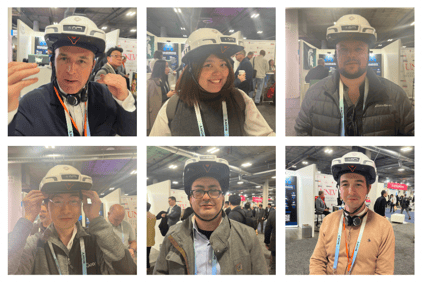

Thank you!
